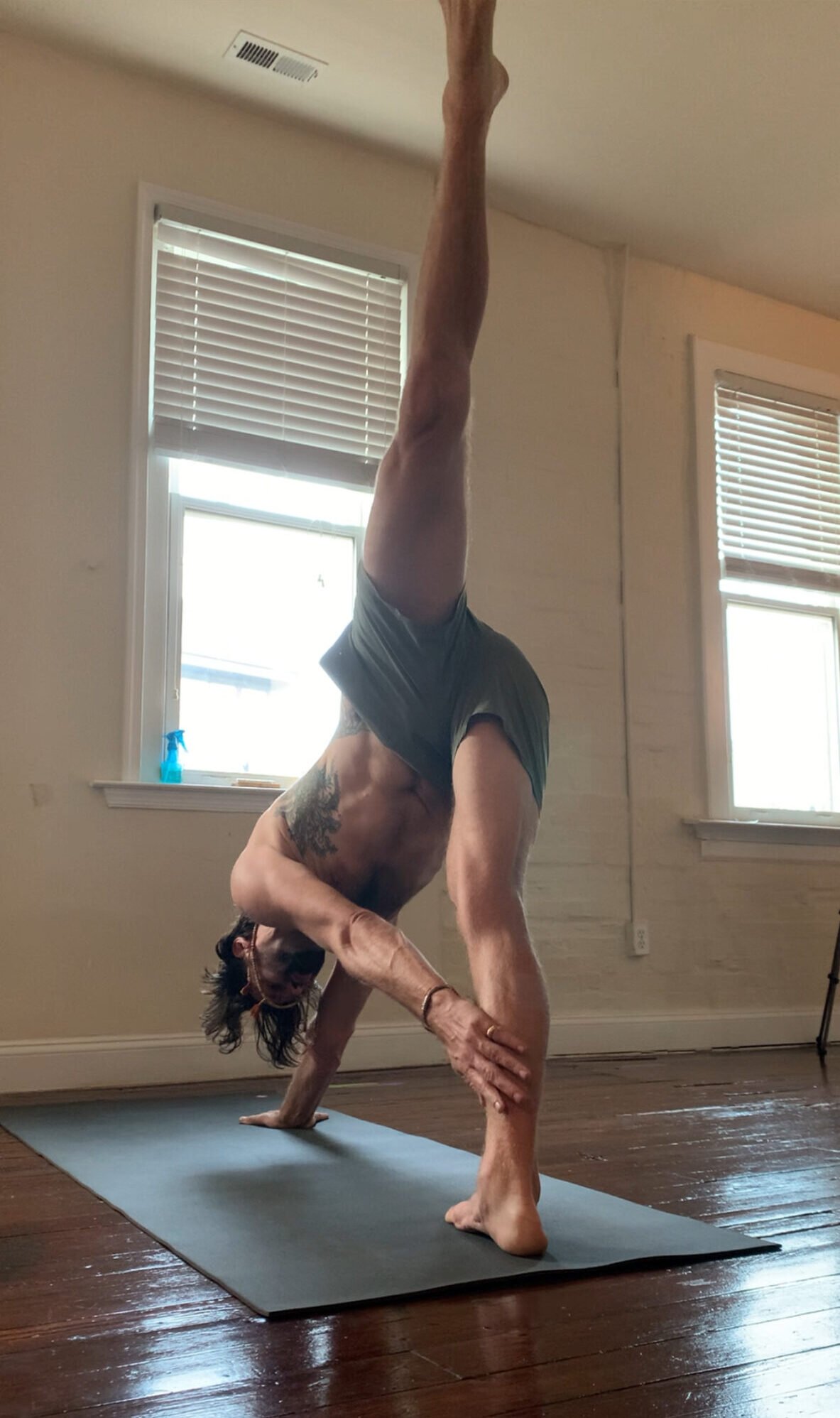What Yoga Teachers Can Learn About Business from Strippers
The first time I realized that I had something to learn from pole dancers was when I was teaching contortion at a pole dancing studio in exchange for private lessons on the Lyra (aerial hoop– it went fine). Some students I knew were nursing sore wrists, but the pole fitness enthusiasts who were also exotic dancers professionally seemed to be able to do twice the amount of stuff with half the prep. I guess if your money depends on you being able to hold on to a pole, you’re gonna take good care of your wrists. That wasn’t the only thing I learned about money from strippers, though.
This article was inspired by a podcast I listened to called “The Economics of Everyday Things”– its a Freakonomics production, which means an analysis and a deep dive into all the strange constituent parts that makes the wheels of a system roll smoothly… or not. This series is all about economics– and as someone who spent their formative years working in a comedy club (and as such spent a lot of time in the entertainment industry), when I saw the one on strippers, I had to listen.
At first glance, yoga teachers and exotic dancers may seem worlds apart in their professional lives, but the stark contrast in their earnings reveals deeper insights into business strategy and market dynamics. Exotic dancers, despite operating in a similarly flexible and self-driven environment, often earn significantly more per hour or per shift than yoga instructors. By exploring these differences, yoga teachers can discover valuable lessons on entrepreneurship, autonomy, and profit maximization.
By borrowing business strategies from exotic dancers, yoga teachers can learn to navigate their careers with greater financial independence and flexibility. Embracing an entrepreneurial mindset, cultivating personal branding, and diversifying income streams can empower yoga instructors to enhance both their earnings and their autonomy, while continuing to share their passion for wellness.
Earning Potential and Market Demand
The core difference between the two professions begins with the stark contrast in market demand. Exotic dancers work in environments where the experience is highly immersive and tied to instant gratification. Customers visiting strip clubs are generally looking for entertainment and indulgence, and they are prepared to spend large amounts in short bursts. This creates an atmosphere where dancers can command higher tips, private dance fees, and VIP experiences, often leading to nightly earnings of $500 to $1,000 or more. The entertainment sector capitalizes on emotional escapism, with the economic transaction fueled by immediate pleasure.
In contrast, the wellness industry—and by extension, yoga—is built on gradual self-improvement. While many people value wellness, there isn’t the same culture of paying premium prices for the service. Most yoga teachers, especially those employed at studios, earn between $50 and $75 per class, with their income limited by how many classes they can teach. The market for yoga thrives on consistency and affordability, driven by long-term goals rather than instant rewards. The willingness to pay top dollar for a moment of entertainment is simply much higher than for a routine wellness class, no matter how transformative yoga can be.
Business Models and Pay Structures
Exotic dancers operate as independent contractors, a model that allows them to keep a significant portion of their earnings. While they must pay house fees to the club (anywhere from $50 to $100 or more) and tip out DJs and bartenders, dancers still walk away with the bulk of their tips. They have the freedom to determine how many hours they work and can significantly scale their earnings based on the clientele, location, and night of the week. The independent contractor model, while carrying financial risks, allows for far greater financial upside than a traditional employee model.
Yoga teachers, on the other hand, are often employed by studios and paid per class. This limits their earnings potential as their income is dictated by how many classes they can fit into a studio’s schedule. Even teachers who are considered independent contractors have less flexibility, as they are constrained by set class times, and the typical flat fee for a class is often disconnected from the actual revenue generated by attendance. Despite being part-time workers, yoga teachers seldom have access to benefits like health insurance, making it difficult for them to achieve financial security, even if they teach multiple classes a week.
Flexibility of Work Hours
One of the main reasons exotic dancers out-earn yoga teachers is the flexibility and high earning potential in a short time span. Dancers often work late-night hours in high-energy environments, where tipping is normalized, and patrons are incentivized to spend large amounts in a condensed timeframe. A successful night in the club, which might last just a few hours, can lead to substantial financial returns.
Yoga teachers, by contrast, are often limited by the structure of the day—early mornings, late afternoons, or weekends. Most studios aren’t packed with back-to-back classes, and teaching more than a few classes a day can be physically exhausting. This caps the number of hours yoga teachers can work and consequently limits their overall earnings.
Market Perception and Pricing
There’s also a stark contrast in the way society views spending on these services. Strip clubs charge patrons significant fees for entertainment because of the nature of the service: it’s indulgent, sensory, and often seen as a luxury. Customers at these establishments expect to tip generously, as it’s part of the culture. Dancers operate in a world where the exchange of money is embedded in the experience, and patrons view their spending as part of the entertainment.
In the yoga world, the perception is vastly different. Yoga is often positioned as a wellness necessity, something that should be accessible to all. This limits the pricing structure, as studios have to compete with the expectation that yoga should be affordable. Even high-end yoga studios have trouble commanding the same level of discretionary spending that entertainment venues enjoy. In a sense, wellness is seen as a routine, while entertainment is seen as an indulgence—leading people to spend more freely on the latter.
Expenses and Longevity
Despite the large sums dancers can make, they face higher expenses. House fees, tipping out staff, and maintaining appearance (clothing, makeup, physical fitness) all contribute to the cost of being an exotic dancer. Additionally, the career is often short-lived, with most dancers earning their peak income in their 20s and early 30s before transitioning into other work. Yoga teaching, on the other hand, can be a lifelong profession, though it often comes at the cost of financial security.
While yoga teachers face fewer upfront costs, such as certification fees, continuing education, and props, their income is more limited. The long-term financial outlook for many yoga teachers is precarious, as they must often supplement their income with private sessions, workshops, or side gigs.
Balancing Passion and Profit
The stark difference between the earnings of yoga teachers and exotic dancers comes down to how society values entertainment versus wellness, the structure of independent contracting, and the culture around spending. Exotic dancers are able to earn far more in a shorter amount of time because of the immediate, indulgent nature of their work and the high value patrons place on that experience. Yoga teachers, despite offering deeply enriching and transformative experiences, operate in a sector where pricing and profit margins are slimmer, and the work is often viewed as a public good rather than a premium service.
To enhance their earning potential, yoga teachers might need to rethink the traditional studio model—perhaps borrowing from other industries like independent contracting, subscription services, or gig economy platforms. By diversifying their income streams and embracing more entrepreneurial models, yoga instructors could bridge the gap between passion and profitability.
The Steps to Make Money Like a Stripper
1. Embrace the Independent Contractor Model
Exotic dancers typically work as independent contractors, controlling their schedules, clientele, and earnings. They pay house fees to clubs, cover their own costs for appearance and attire, but in return, they have the freedom to maximize their earnings through tips, private dances, and other services.
Lesson for Yoga Teachers: Many yoga instructors are paid per class at studios, with limited opportunities to scale their earnings. Shifting toward an independent contractor model, where teachers rent space, offer private sessions, or run workshops, could give them more control over their income. Like exotic dancers, teachers can focus on building a loyal clientele and providing personalized services at a premium.
2. Create Multiple Income Streams
Exotic dancers earn money through tips, private dances, and special performances. They don’t rely on just one form of income but diversify within their profession to maximize earnings every night.
Lesson for Yoga Teachers: In addition to teaching classes, yoga instructors can diversify their income by offering private lessons, teacher training, online courses, or retreats. Creating multiple revenue streams reduces dependence on studio schedules and provides financial stability.
3. Leverage Personal Branding
Exotic dancers often build personal brands that attract regular clients and create a loyal following. They invest in their appearance and persona, knowing that these factors increase their earning potential.
Lesson for Yoga Teachers: Yoga instructors can similarly invest in building their personal brand through social media, workshops, and content creation. Developing a distinct teaching style or niche (e.g., yoga for athletes, prenatal yoga) can attract a specific audience willing to pay more for specialized services. Teachers who cultivate a strong personal brand often have greater leverage in setting their rates and attracting loyal students.
4. Maximize Peak Hours
Exotic dancers work during peak hours—typically nights and weekends—when clubs are busiest and clients are more willing to spend. They capitalize on the high-demand periods to maximize their earnings.
Lesson for Yoga Teachers: Yoga instructors can increase their earnings by offering classes or workshops during high-demand times (mornings, evenings, or weekends). Additionally, they can look for ways to offer premium experiences during peak hours, such as private sessions, advanced classes, or themed events that cater to students willing to pay extra for a more intimate or specialized experience.
5. Understand Your Clientele
Exotic dancers know their clients’ desires and cater to them, adjusting their approach to maximize tips and private bookings. They observe what works and build relationships with their customers to ensure repeat business.
Lesson for Yoga Teachers: Yoga teachers should take time to understand their students’ needs and preferences. Whether students seek stress relief, physical fitness, or community, tailoring classes to meet these demands can create a more engaged, loyal student base. Teachers who listen to their students and offer personalized recommendations can foster long-term relationships, just as dancers do with their clients.
What Did We Learn Here?
The yoga industry, though deeply rewarding on a personal and spiritual level, often leaves teachers financially constrained, earning far less than professionals in seemingly unrelated fields like exotic dancing. This raises a provocative question: why is there such a stark difference between the market caps for yoga instructors and exotic dancers? Despite both professions involving physical exertion, self-presentation, and audience engagement, exotic dancers can earn significantly more in a single night than many yoga teachers make in a week. Examining the structural, cultural, and financial dynamics behind each profession can offer key insights into the economics of wellness versus entertainment.






